Council Okays Streetcar to Bucks Arena
$40 million extension would add .75 miles to route, also connect convention center.
The Milwaukee Streetcar is about to get longer, should the federal government award it a $20 million grant. Following a 11-4 vote by the Milwaukee Common Council, a nearly one-mile extension of the Milwaukee Streetcar has been approved that would connect the route with the new Milwaukee Bucks arena. The extension would also serve as a starting point for connecting the streetcar with Bronzeville and other neighborhoods to the north of Downtown.
The new project would extend the streetcar three-fourths of a mile north, running from the route’s current western terminus at the Milwaukee Intermodal Station at W. St. Paul Ave. and then up N. 4th St. to the new Bucks arena and Live Block at N. 4th St. and W. Juneau Ave. The stop would be partially located in the portion of N. 4th St. that will be permanently closed to traffic as part of the arena project.
The planned line would connect not only the new arena to the system, but would also include a stop at the Wisconsin Center convention center in a new public plaza. That plaza would be created as part of a new development in the surface parking lot at N. 4th St. and W. Wisconsin Ave. The city recently issued a request-for-proposals for the land. A future stop is also planned at the intersection of W. Kilbourn Ave and N. 4th St.
If all goes according to plan, service would begin on the extension in the spring or summer of 2020. Construction on the extension would start following the fall 2017 completion of the final design of the extension.
The extension will look and operate substantially different than the system’s first two phases. Much of the route will be in a dedicated lane on N. 4th St., instead of running with mixed traffic. In addition, a substantial portion of the extension will be built without overhead wires for power. The Brookville-manufactured vehicles can accommodate operating on batteries for portions of the route (they get recharged by wires at the stations) and the city intends to make use of that technology to lower construction costs.
The first phase of the system, connecting the Lower East Side, East Town and Historic Third Ward with the Milwaukee Intermodal Station, is on-track to begin service in 2018. Utility work on the route is currently underway. Construction of the track is set to begin in the coming weeks. Work will occur in phases across the 2.1 mile route.
Concurrently underway is work on the streetcar’s lakefront extension. That spur, approved and fully-funded, will add four-tenths of a mile to the route split across E. Michigan St. and E. Clybourn St. That extension will run from N. Milwaukee St. to the base of the planned The Couture tower at N. Lincoln Memorial Dr. The lakefront extension is anticipated to open after the first phase of the streetcar opens.
Extension Renderings and Maps
Extension Costs
- Guideway and Track Elements – $3.4 million
- Stations, Stops and Terminal – $0.5 million
- Sitework and Special Conditions – $14.7 million
- Systems – $3.3 million
- Vehicles – $4.5 million
- Professional Services – $3.5 million
- Contingency – $7.2 million
- Escalation to 2020 Dollars (inflation) – $2.8 million
- Total – $39.9 million
Extension Funding Sources
- Federal – TIGER grant – $20 million
- Local – TID 39 Amendment (Hilton City Center) – $4 million
- Local – TID 41 Amendment (Time Warner Cable/Manpower) – $8 million
- Local – TID 88 Creation (4th/Wisconsin) – $8 million
- Total – $40 million
What’s Next for the Milwaukee Streetcar?
During his stump speeches for the streetcar, Mayor Tom Barrett repeatedly said his goal was to get the first phase in the ground and immediately start working to extend it. His administration has done just that. The initial project approval came with an lakefront extension. Now they’ve secured approval, pending a federal grant, to extend the streetcar to the north. What’s next?
A major extension is in conceptual planning stages to extend the system north into Bronzeville and south into Walker’s Point. The three-and-a-half mile route, which would utilize the N. 4th Street extension, would run from W. North Ave. and N. Dr. Martin Luther King Dr. to S. 1st St. and Greenfield Ave. That extension would roughly double the size of the system.
Should the city fail to receive the federal grant, the city would continue to design the extension using the tax-incremental financing funds.
Streetcar Not As Controversial Anymore?
Observers of the original approval process for the system will remember how many procedural moves were used to attempt to block the system. Those moves, which ultimately caused months of delay, were nowhere to be found today. In a simple up-down vote, council members Robert Donovan, Mark Borkowski, Jim Bohl and Tony Zielinski voted against the project.
Only Borkowski spoke against the matter, perhaps because he wasn’t on the council for the previous battles. Borkowski lamented that “the discussion of whether or not the streetcar will happen, that ship has sailed.” Warning that Milwaukee was becoming a tale of two cities, Borkowski went on to ask: “where is the help, where is the assistance, where is the cooperation for the rest of the city? I’m told that with this development the rest of the city will see benefits. Well I’m not sure of that. But if it does happen, when will it happen? I think it’s dangerous to put all our eggs in one basket, if you will, and realize that we have other, greater challenges in the city as a whole beyond just the downtown. I challenge all of us, the Mayor and all of us Common Council members to remember that the city of Milwaukee is a large city and not just downtown.”
More about the Milwaukee Streetcar
For more project details, including the project timeline, financing, route and possible extensions, see our extensive past coverage.
- Another Streetcar Collision - Jeramey Jannene - Jun 27th, 2025
- Streetcar Hit By Apparent Red Light Runner - Jeramey Jannene - Jun 16th, 2025
- Streetcar Will Run On Consolidated Route During Summerfest - Jeramey Jannene - Jun 11th, 2025
- City Hall: Milwaukee Must Replace Failing Streetcar Switches - Jeramey Jannene - Feb 24th, 2025
- Streetcar Confronts Limited Funding, Operations Challenges - Evan Casey - Jan 22nd, 2025
- Council Kills Streetcar’s ‘Festivals Line’ - Jeramey Jannene - Jul 31st, 2024
- Streetcar Will Use Festivals-Oriented Route Through Summer - Jeramey Jannene - Jul 9th, 2024
- The Hop’s Lines Will Merge For Easier Summerfest Service - Jeramey Jannene - May 30th, 2024
- Streetcar Begins Daily Service To The Couture, BRT Will Soon Follow - Jeramey Jannene - Apr 11th, 2024
- Milwaukee’s Three Streetcar Extensions Need Mayoral Direction - Jeramey Jannene - Nov 8th, 2023
Read more about Milwaukee Streetcar here
More about the New Bucks Arena
- Murphy’s Law: Bucks Violating Promises on Unions? - Bruce Murphy - Jun 5th, 2025
- Back in the News: Bucks Owners Continue to Cash In - Bruce Murphy - Nov 28th, 2022
- Murphy’s Law: Bucks Subsidy An Issue in US Senate Race - Bruce Murphy - May 9th, 2022
- Murphy’s Law: Bucks Franchise Worth $1.86 Billion - Bruce Murphy - Jan 25th, 2021
- Op Ed: County Parks Lost Funding to Bucks Arena - Patricia Jursik - Jul 7th, 2020
- Eyes on Milwaukee: Fiserv Forum Workers to Get $15/Hour - Jeramey Jannene - Jan 29th, 2020
- Eyes on Milwaukee: Bucks Beat Hiring Targets on Fiserv Forum - Jeramey Jannene - Nov 20th, 2019
- Murphy’s Law: Taxpayers Make Bucks, Brewers Rich - Bruce Murphy - Apr 16th, 2019
- Eyes on Milwaukee: Bucks Unveil Master Plan for Park East - Jeramey Jannene - Mar 15th, 2019
- Eyes on Milwaukee: Bucks Plan Massive Arena Signs - Jeramey Jannene - Feb 12th, 2019
Read more about New Bucks Arena here
Political Contributions Tracker
Displaying political contributions between people mentioned in this story. Learn more.
- September 8, 2015 - Robert Donovan received $50 from Mark Borkowski
Eyes on Milwaukee
-
Church, Cupid Partner On Affordable Housing
 Dec 4th, 2023 by Jeramey Jannene
Dec 4th, 2023 by Jeramey Jannene
-
Downtown Building Sells For Nearly Twice Its Assessed Value
 Nov 12th, 2023 by Jeramey Jannene
Nov 12th, 2023 by Jeramey Jannene
-
Immigration Office Moving To 310W Building
 Oct 25th, 2023 by Jeramey Jannene
Oct 25th, 2023 by Jeramey Jannene


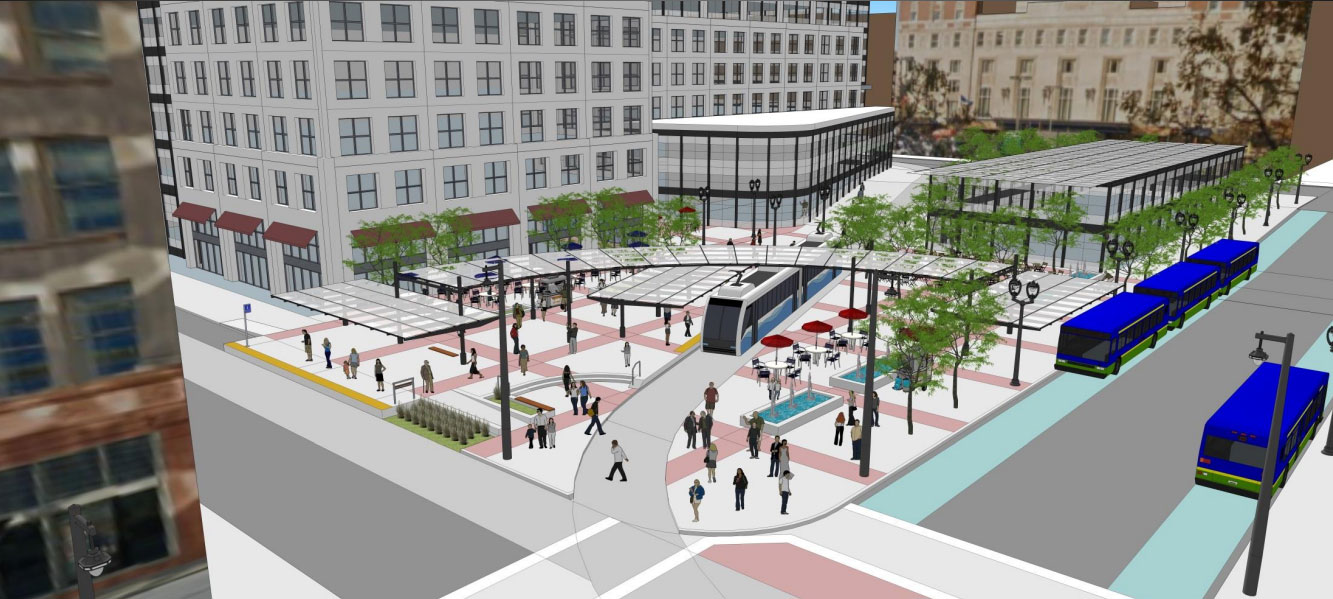
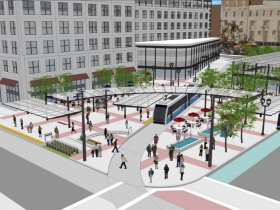
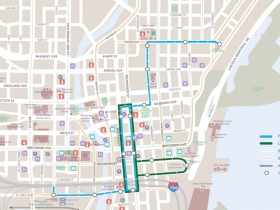
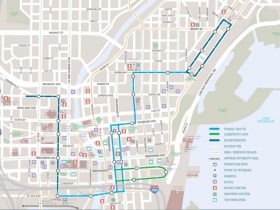
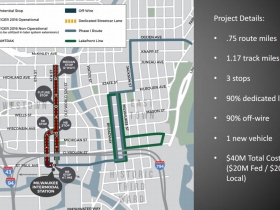
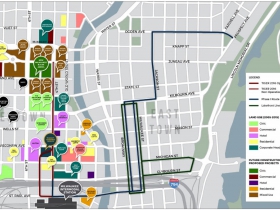
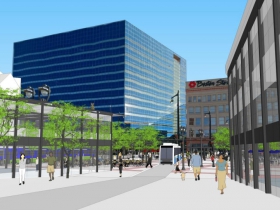




















If this is going to be successful we’ll need a lot of extensions. I’m not confident that this particular extension is the right one to start with, but it may be more political than anything else.
Is the streetcar going to have signal priority? It better.
As a long time supporter of the streetcar, I really hate to see the constant lack of proper urban planning principals being applied to how the streetcar is being planned. I don’t know of any reputable urban planners who would advocate for the routes which are currently being planned, and the methodology of how they are being planned. The routes look like they are gerrymandered in a way that only a true politician would like. The routes are being planned to solely accommodate real estate interests while ignoring the needs of the current and future residents of Milwaukee.
I cant tell which idea is worse… running the streetcar through the middle of a plaza, or running the streetcar route diagonally through an intersection?
By running it through the plaza you are permanently insuring that either the plaza cannot be used for large events, or that the streetcar will be shut down anytime there is an event in the plaza.
By running the streetcar diagonally through the intersection you are insuring that all vehicular traffic from both cross streets will have to stop when the streetcar passes increasing the average length of time all vehicles will be stopped at the intersection, and you are making the intersection inhospitable to pedestrians by increasing the crossing distances and making the southwest corner of the crosswalk unusable as the streetcar now passes over it.
Matthew (post 2):
Running a streetcar diagonally into or out of an intersection isn’t unusual. In St Paul, for example, the Green Line enters and leaves a street diagonally (at 4th and Minnesota Streets and again a block away at 5th and Cedar) where the Green Line runs through (and stops at) a similar plaza.
I visited St Paul last summer and stayed about 2 blocks from that block and can assure you that the corners are quite hospitable to pedestrians.
To see how well pedestrians and streetcars can co-exist, watch this amazing live web-cam from Amsterdam. (Amsterdam is 7 hours ahead of Milwaukee; at 5pm in MKE for example, it is midnight in Amsterdam. Try to watch during Amsterdam’s daylight hours.)
https://www.terena.org/webcam/
In Milwaukee, 4th and Wisconsin will have a special “streetcar only” signal phase which will only come on when there is a streetcar ready to enter the intersection. There will be similar “streetcar only” signals everyplace the streetcar turns left. It’s conceptually similar to common left-turn green arrows except that it is only for streetcars, not general traffic.
Good questions about streetcar plans, Matthew.
However, the diagonal is proposed across a block to be developed, not a street, as far as I can tell.
But I too wonder about the streetcar routes and the fact that whenever new “public plaza” are mentioned they sound like glorified commercial plazas. Just built with taxpayer money. The Couture streetcar depot, Bucks Mall Plaza, streetcar stop in the new 4th St. & Wisconsin development. Will any of them live up to worthy standards of public spaces–and thus serve the greater good?
Are the powers-that-be gerrymandering streetcar stops and “public” spaces to serve their special interests? Let’s push for something better, at least for OUR public spaces.
Every major city, and many minor ones that I have visited already have a streetcar or light rail of some type. I have used this public transit often any time I visit those cities. I feel opposition to the Milwaukee plan is because many people here never go anywhere.
Matthew,
Re: concerns about the streetcar running through the Bucks 4th Street pedestrian mall, the Bucks lease and arena-related law have already ensured that the plaza can ONLY be used for events to benefit the Bucks and their affiliates. The Bucks can also charge admission fees to events on their plaza, so it will be “public” in name only, with or without a streetcar. It will surely be designed to protect the Bucks owners’ interests and the streetcar will help bring people to those entertainment venues and events hosted there.
However, another urban-planning issue is that Old World Third Street will now have to serve as the major thoroughfare in that neighborhood–and cannot become more pedestrian friendly through wider sidewalks, etc. I suspect the Old-World-ly brick cobbles might have to be removed (they’re already not in good shape). Some traffic during arena events will also be diverted to 6th Street, but Westown will likely have even more bottlenecks, one-way streets, etc.
But at least the streetcar might relieve some congestion and can help take people from one hot spot to another. That could also reduce potential driving by people who are drinking, at least among downtown residents.
The detailed map you posted as “Picture 4 of 8” seems to have an error. The NB (Northbound) and SB stops at Wisconsin are interchanged—the NB stop is on the SB track and the SB stop on the NB track.
Also, since the streetcar’s OMF (operations/maintenance facility) will occupy the entire the south side of Clybourn between 4th and 5th (using land covered by I-794), I assume there will be a track connection from the OMF to the 5th St tracks (besides the previously shown connection at 4th St).
I appreciate the thoughtfulness and concerns expresses in earlier posts about the streetcar project.
I’m unclear as to why the extension route needs to go north on 5th Street just two blocks before jogging back to 4th Street, I suspect it is to satisfy Marcus Corp./Hilton Hotel so that it is not left on the periphery. Bad move. Just using 4th Street makes more sense and would totally free up the plaza for greater purposes.
A friend who lives in Milwaukee complained to me over cocktails the other week that, without overhead electric power, the extension is simply a glorified bus. While I’m sure fare prepayment and boarding/aligtghting at grade will still be a part of the plan (i.e., the streetcars, themselves, will still be the same), I tend to agree. And, I’m all for the streetcar!
All this said, politics and business interests will play a role. that’s how it is going to get funded.
This will be a critical downtown intersection, M’waukee. Don’t screw it up!
(PS – What about the Business Journal post on July 4th talking about how developers are “spilt” over whether development of 4th and Wisconsin will compete with Bucks Plaza? I personally think both can be done, successfully, but wonder how much “entertainment” downtown can handle. For this reason, I would prioritize residential and a bit of commercial/retail at 4th and Wis.)
Glad to see comments I agree with. Dear planners… PLEASE read these comments! We love the streetcar but any time a streetcar is forced to make a turn you KILL its effectiveness. Yes some turns are needed but it needs to be as straight line as possible even if that means you have to walk an extra block. This is not a novelty children’s ride. This is a legitimate form of transit that needs to be treated as such! Don’t snake it through that plaza – no matter how cool it looks!!!!
I was surprised by the 5th Street routing, since it appeared in no earlier streetcar document. That routing is even more surprising because there are no stops on 5th St (unless you count the new plaza on Wisconsin between 4th and 5th).
That said, I see several advantages to the 5th St alignment.
• It allows the streetcar to stop closer to the train station. Under earlier plans, the nearest stop was one block away—on 4th a little north of St. Paul (and out-of-sight if that parking lot gets developed). While the SB (or, more accurately, EB) stop remains there, the NB/WB stop will now actually be across the street (and fully visible) from the train station.
• It simplifies access to the OMF (Operations & Maintenance Facility—underneath I-794 on Clybourn between 4th and 5th). Streetcars will be stored overnight in the OMF, and you need access to and from tracks in each direction.
A NB track on 4th would be on the far side of 4th and the “on-ramp” from the OMF might stretch into the intersection of 4th and Clybourn. If, for any reason, 4th between St. Paul and Clybourn were closed, the entire OMF would be unreachable. Moving the NB track to 5th solves both problems.
• It allows the Wisconsin Avenue plaza itself.
While the plaza idea surprised me, I like the idea. The stop at 4th/Wisconsin may well be the single busiest stop on the streetcar because it is the primary connection to/from MCTS and because the Hilton, Convention Center, and Grand Avenue are right there. If done right, the plaza could create a new downtown focal point and spur Westown development.
People probably fear another “dead” plaza like MacArthur Square, but MacArthur failed in large part because it is elevated above eye-level from the surrounding streets; this won’t be.
Still, I’m not totally sold on the 5th Street alignment. I agree with Tyrells comments (post 9) about minimizing turns (especially when the added turns don’t serve even a single new station). I assume there was some additional reason (like utility relocation expense or no room for a dedicated lane) that the NB track was moved to 5th.
If the route is to be split between 4th and 5th Streets, I think it might be better to flip the directions—running northbound on 4th St and SB on 5th. This would avoid having the streetcar mainline track cross each other in two places (4th/St Paul and 4th/Wisconsin).
This would also move the streetcar even closer to the Amtrak station; it would be right in front of the station instead of being across the street.
MidnightSon (post 8),
Even without overhead wires, the streetcar will still be distinct from a glorified MCTS bus:
• 3x the capacity (150 vs 50, including standees)
• very quiet
• no tailpipe emissions
• faster boarding and unloading
• no time lost merging back into traffic after stops
• continuously-updated wait time display at each stop
• shelters from rain at each stop
• lighting at each stop
• a MUCH smoother ride
Tom D (post 12)
Thanks, Tom…that makes total sense! I’ll share with my skeptical drinking buddy!
I’m glad this route goes north. I hope it keeps going.
Interesting comments about the public plaza. It’s sad that MKE has so screwed up public spaces that it breeds doubt that any can be done well here. Hey, the rest of the world is creating all types of successful public spaces, including fixing ones that were not working. It’s not rocket science. How about doing a little field research–even by driving to Madison, a national model?
Not sure why the public realm is
an Achilles heel for the mayor and Marcoux. They may be cheerleaders for Milwaukee but neither seems to value or understand the role of public spaces. It’s hurting MKE and private development–and a terrific lakefront–cannot make up for those lacks.
And please don’t let the Bucks control what development happens in all of Westown or Downtown will really be doomed!
Maybe the route resides on 5th Street because there is little opposition by local businesses. Since no businesses exist on 5th St,
Jason, others have said routes seem to be the result of businesses lobbying for them–not opposing them. The main business on 5th St. is the Hilton.
“@Marie” That’s simply not correct.
Tom(12), in response to your claims that this streetcar is more than a glorified bus:
• 3x the capacity (150 vs 50, including standees)
You could run three buses and achieve the same effect.
• very quiet
Wheel to rail contact makes noise. Is the sound of transit really that big a concern for anyone downtown? Also this has nothing to do with getting people where they need to go.
• no tailpipe emissions
Electricity production has emissions whether you see them or not. There are also low emissions buses.
• faster boarding and unloading
Modern buses have off-board fare collection and near-level boarding. Just because MCTS buses don’t have that (yet) doesn’t mean a streetcar is objectively better than a bus. It just means it’s better than our bus, and newer buses could be had at a fraction of the cost of the streetcar.
• no time lost merging back into traffic after stops
Milwaukee’s streetcar will “operate in shared traffic” and will ” operate in the same lanes as other vehicles” according to the streetcar’s own website.
• continuously-updated wait time display at each stop
Can be done just as easily at a bus stop.
• shelters from rain at each stop
Can be done just as easily at a bus stop.
• lighting at each stop
Can be done just as easily at a bus stop.
• a MUCH smoother ride
Only with dramatic surface improvements and constant maintenance, the same of which can be done to a road.
To be clear, I am not your typical anti-transit poster, so please do not pigeonhole me. I ride the bus daily to work and am an advocate of tremendous investment in transit expansion, I just wish it would be done in a smart way. I see a shared-traffic streetcar as the absolute worst means of expanding transit, and am tired of people ignorant of new bus technology pretending streetcars are dramatically superior.
@Dave Reid: I was referring to what others wrote above. Though I can see that it sounds like I agree with those statements. I have no knowledge about how streetcar routes have been developed although I know there has been much input over time. Did not mean to endorse previous commenters’ opinions.
Yes, I am sure local businesses want the parking spaces in front of their shops removed for public transportation. I can smell the profit.
Joe (post 18):
Here are my responses to your points:
• Vehicle capacity
The operating cost (as distinct from the acquisition/construction cost) of a 150-passenger streetcar is roughly the same as a 50-passenger bus. (The biggest single expense of either is the driver’s salary and benefits.) “Running 3 buses” instead of one streetcar triples your operating cost.
• Noise
Modern streetcars are almost silent. They use continuous welded rail (eliminating the “clickety-clack” of old streetcars) and “flange lubricators” (eliminating squeals on curves).
• Tailpipe emissions
Electricity generated from wind and sun creates zero emissions. Calgary, Alberta powers its 37-mile LRT system entirely with emission-free wind-generated electricity. The cost of upgrading the streetcar’s power to clean energy would be a pittance—under $35,000/year (1.4 million kWh at under 2.5 cents per kWh for the initial 2.1 mile system).
• Level boarding
Level boarding is useless unless the vehicle door is close to the curb. While buses can pull right up to the curb, they seldom actually do (and even when they do at the front door, the back door is almost always at least a foot from the curb). Streetcars always stop within a few inches of the curb.
• Time lost merging back into traffic
When a bus stops, it pulls into the parking lane. When it leaves the stop, it waits for a break in traffic before it can proceed. The streetcar doesn’t wait like this because it never pulled out of the traffic lane in the first place—it stops in the traffic lane; vehicles behind the streetcar must go around it or wait.
• Other features (off-board fare collection, stops with shelters, lights, and real-time wait information)
Yes, buses can have these, too (but they don’t—except for shelters at a handful of stops—and probably never will). And installing these features increases costs toward what a full-blown streetcar would cost. Making these features standard at bus stops would reduce the ability to quickly and cheaply change bus routes (since a bus route change would require new shelter installation).
• Smooth ride
The streetcar runs on rails and never touches the concrete/asphalt road surface. The rail surface is extremely smooth and is exactly the “dramatic surface improvement” you mentioned.
• Reduced turnaround time
(I forgot this item in my original post.)
When a bus reaches the end of its run, it must turn around, usually by looping around a block and making 4 time-consuming turns (even more time-consuming if there is a traffic signal at every corner).
Streetcars simply don’t need to do this, they are bi-directional (each end has a driver seat, headlights and taillights). As soon as the driver walks the length of the streetcar (which he must do anyway to look for abandoned articles, etc) the streetcar is facing the right way.
The City projects that each streetcar will need a little under 15 minutes for a one-way trip between 4th/St Paul and Prospect/Ogden. Even 90 seconds saved (by not looping) is over 10% of total running time—nothing to sneeze at.
Here’s the MBJ article MidnightSon (#8) referred to about developers not wanting to compete with the Bucks plans to create an “entertainment” vortex:
http://www.bizjournals.com/milwaukee/blog/real_estate/2016/07/could-fourth-and-wisconsin-development-conflict.html
I hope developers don’t think they must cede that whole realm to the visiting Manhattan real-estate moguls. But steroidal packaged “entertainment” is often feast or famine. Monocultures are vulnerable. Existing businesses on Third and Water Streets may have more to worry about in terms of market oversaturation and cannibalization than Wisconsin Avenue does–if it grows incrementally in balanced ways.
And let’s hope city officials facilitate a truly public space on 4th & Wisconsin that’s welcoming to everyone and caters to multiple activities. That will build demand, as well as what’s already there with convention center, businesses, offices, etc. And places with authentic local character are likely to trump generic knock-offs, which the Bucks say will predominate in their sports bar mall.
Virginia, I’m with you. It was just a couple months ago the the MBJ called this one of the most pivotal, developable sites in downtown. Now, it sounds like its kowtowing to the Bucks. Just four days later, the MBJ published an editorial that clearly was meant to back track a bit, but comes off as obligatory and totally lame. They got a call from someone in City Development.
http://www.bizjournals.com/milwaukee/news/2016/07/08/move-ahead-on-fourth-and-wisconsin.html
“At a recent Milwaukee Business Journal Real Estate Roundtable, several area developers said the property is best used for entertainment or hotels, which could conflict with the Milwaukee Bucks owners’ plans for land around the downtown arena north of the central business district.
“The concerns make sense, but should not stand in the way of city officials reviewing what developers bring forward to determine if the long-vacant site can finally be activated.” (End of excerpt)
A part of me wonders if its just developers who don’t get that “entertainment” in Milwaukee can mean more than sports bars. And, nothing says that a hotel needs to be there. I’ve got my eyes on a couple of sites closer to Kilbourn Avenue for that. 😉 That said, there is plenty that can go on the first level of 4th & Wisconsin that will activate the space. And, frankly, the ore I think about this the more I want residential and smaller office space there. (Kilbourntown should become more like the Third Ward in that regard.)
Here’s the RFP:
http://city.milwaukee.gov/ImageLibrary/Groups/cityDCD/RFP/4thWI_RFP_2016_FINAL.pdf
I do like the potential of the Pavilion, and the criterion that it be transparent (although one is left wondering how public restrooms will be transparent!) 🙂
It doesn’t look like there will be much space in the plaza for any kind of structured activity, although the simple fact of having buses come through can be engaging enough for many. (On that note, I wonder if there is some sort of “show” that can be designed around train street car and BRT arrivals and departures. (n San Francisco, its great, old school fun to watch the cable car operators physically turn the cars around before their return trips.)
Of course, this won’t be a terminus, but how about something like a light installation (or light and sound installation) in the plaza–and also along 4th, 5th, and Wisconsin Ave.– that announces the arrival of a train. Something like what is being installed down here for Chicago under the Wabash Street El tracks:
http://www.thewabashlights.com/
Although that installation would be programmable by anyone with the app (not a bad idea), I’m thinking of something perhaps less interactive and more indicative. Something that conventioneers, residents, guest at the Hilton, diners at The Capital Grille, and even streetcar and BRT riders can have a bit of fun with. “Oh, you were just in Milwaukee? Did you see the streetcar lights?!” (I mean, how many of us grew up in Milwaukee knowing what the weather was going to be like the next day by the color of the flame on the Gas Building?!)
Blah blah blah. 10:00pm and MidnightSon is going to bed…
Midnight Son, thanks for the update about the MBJ backtracking. Agree that “entertainment” need not mean only sports bars. One reason for Chicago’s Millennium Park’s huge success in drawing people downtown is that they host multiple FREE events there virtually every day of the year for all ages and all interests, plus the cool art, gardens, fountains, etc. http://www.cityofchicago.org/city/en/depts/dca/supp_info/millennium_park.html
They also created the very active family-oriented Maggie Daley Park next door. And property values around have skyrocketed around both. I don’t expect anything that ambitious in MKE but we tend to forget that investing in vibrant public spaces can yield huge tax-base returns–especially in the thick of downtowns.
And what about the big plans announced by Grand Avenue folks for restaurants and Public Market-type retail? I hope entrepreneurs forget the kowtowing and run their own game. Now’s not the time to get cold feet about Kilbourntown.
http://urbanmilwaukee.com/2016/04/25/eyes-on-milwaukee-meet-the-new-grand-avenue/
Sure, the streetcar will likely increase all connectivity throughout downtown but Wisconsin Avenue, with the right attention and development, could and should become the center of gravity once again–with ALL types of uses (there’s already plenty of businesses and theaters and growing residential). With more restaurants and useful retail at Grand Avenue and elsewhere, and some community events inside the mall, an outdoor (and possibly indoor) public space on 4th & Wisconsin would be complementary. Great cities have interconnected public-space networks. We certainly don’t have too many functional ones in downtown proper and not a one on Wisconsin Avenue till it terminates at O’Donnell Park.
MidnightSon (post 23):
Thanks for the link to the 4th/Wisconsin site RFP! It is an interesting document!
The map on page 8 seems to show the two-way streetcar running on a single track north of Wisconsin. I don’t know if this is just a sloppy map (there are other examples of haste in this document, like not identifying item “13”—most likely the Summerfest grounds—on page 6), or if they really intend to save money with single track there.
And, having seen that document, I’d like to bring up a grammatical pet peeve…
The document uses busses (instead of buses) as the plural of bus . Although dictionaries say either spelling is acceptable, busses can be ambiguous because it is also the only plural of buss—meaning “kiss”.
For example, if you saw the sentence “Busses are prohibited in the Kiss-and-Ride lot”, what would that really mean? To prevent this ambiguity, major newspapers, like the NY Times use only buses in this context.
Virginia Small (post 24), you can thank the freeways for the lack of any downtown parks along Wisconsin Avenue.
Red Arrow Park was on the south side of Wisconsin between 10th and 11th Streets until the freeways took that block (and the park). Only the name was saved and recycled.
Mark my words! A street car line going right up to the Bucks property will just lead to Socialism. And when it does, some of us who have never purchased a professional sports ticket or never entered some of Milwaukee’s professional sports venues may just take the opportunity to do so.
Gary, Interesting musing about a potential revival of “Socialism” in the city that made it famous starting with the first Socialist mayor in 1900. While a taxpayer-subsidized streetcar continues that heritage, there are sticky logistics to work out with the planned privatized 4th Street plaza. The city’s lease gives the Bucks the right to charge admission to events on the plaza. So will the streetcar have to stop before reaching the plaza and reverse course during such events to keep random riders from accidentally crashing the Bucks party? And how will they wall off a so-called public plaza?
Of course, taxpayers’ “investment” in a Bucks Arena and Bucks Plaza is a classic example of “privatizing profits and socializing costs, risk or loss” (or what some call a rigged system).
http://www.investopedia.com/terms/p/privatizing-profits-and-socializing-losses.asp
Marie (post 28), the new arena is on 4th between Highland and Juneau, and there will be no streetcar stops on that block; it will pass through without stopping. (How they let the streetcar through but keep the non-paying public out is—or should be—at the Bucks’ expense.)
This extension has a stop just south of Highland (which you can see on “Picture 4 of 8” above). The next stop (which would be part of another extension) would be somewhere north that block.
Tom D., thanks for the explanation of how the streetcar will not interrupt the Bucks from being able to restrict access to their in-name-only “public plaza.” Let’s hope the route someday continues beyond the expensive, nonfunctional track through Bucks Plaza. And so far the taxpayers are usually on the hook for what we should otherwise expect the Bucks to pay for that benefits only them.
And I’m with you on the spelling of “buses”!